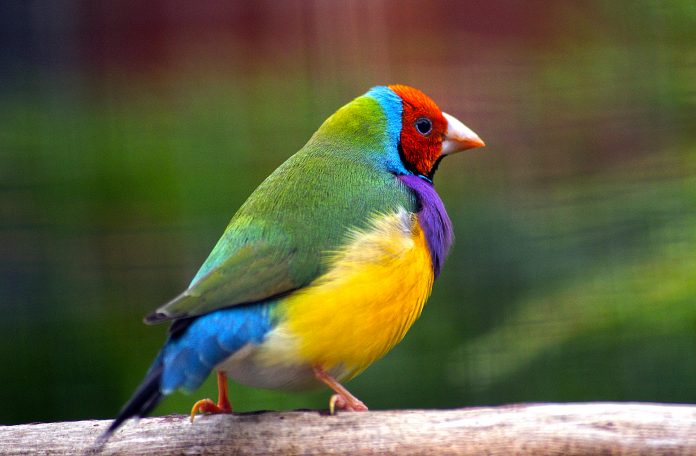Gouldian Finch is bold coloring and has brought the brilliant finch fame as a caged bird and misfortune in the wild. Once widespread through the grassy subcoastal woodlands of northern Australia, from the Kimberleys to the Cape York Peninsula, it has now withdrawn from nearly half its range. The colonies around the Gulf of Carpentaria and on the Cape York Peninsula have almost gone.

Even in the Kimberleys and Arnhem Land, where it is still locally common in savannas dotted with tall trees around permanent waters, the flocks of thousands that flourished fifty years ago have dwindled to tens and hundreds. The reasons may be trapping for the bird trade and too-regular firing of feeding grounds. Gouldian Finches feed on a range of many seeding types of grass, not on the ground but by climbing and clinging to vertical spikes to pick out grains as manikins do.
These finches are very expert in catching flying ants in mid-flight and during breeding become almost entirely insectivorous, feeding young on a protein-rich diet. Following their food, Gouldian Finches are moderately migratory. In the winter dry season, they migrate coast wards as grasses die off inland, then follow the rejuvenating rains back in the summer wet to breed.
Like most manikins, the colorful Gouldian Finches are social birds, living together in small to large flocks. If flushed, they fly as a group to the very tops of in close proximity trees to sit and hop about with blue rumps noticeably displayed and tails flicking deeply up and down.
They also join in daily bouts of sunbathing and drinking at pools; drinking is by sucking. There is no huddling or allopreening, though, nor do they sleep together in roost nests. Pairs court on horizontal twigs in the middle of trees. The male finch may hold a grass stem in pre-play but soon drops it.
Fluffing his head and breast and raising his tail to highlight his colors, he sits in front of the female and bows and shakes, moving his bill rapidly to and fro over the perch and occasionally wiping it. Then he jerks rapidly erect and, tail depressed, begins a whisper song with Bill held down and his head swinging from side to side. After repeats, males and females fly to the nest and copulate inside.
These Gouldians are the exclusive Australian finches to nest exclusively in hollows in trees or termite mounds. They are poor nest-builders putting together only the rudiments or not even that-but they do nest socially in loose colonies. Up to six pairs will nest in a single tree, some in the same hollow together. Each rears two or three broods a season.
Both parents incubate and brood in shifts, relieving one another inside the nest; only the female sleeps in the nest at night. After fledging, the young may retain their juvenile plumage for six months or more, even breeding in it. Gouldian Finch is also known as Purple-breasted Finch, Purple-chested Finch, and Rainbow Finch.
The size of Gouldian Finch is about 135-145 mm. The male crown and face mask are black in most birds (70-80%), dull crimson in minority (20-30%), and ochre-yellow in rare defectives. Back and wings grass-green; rump, upper tail coverts blue; tail black, pointed.
Chin and throat black; breast band lilac; belly yellow; undertail white and eyes are dark brown, along with bill ivory with a red tip. Feet pale yellow. The female finch is a little duller. The immature bird is dull ash-gray overhead to olive over back and tail, brown-white below; maxilla dusky, pale nodules at the gape.

The call of Gouldian Finch is consist of variations of reedy ssitt in contact and alarm, often repeated. The song of Gouldian Finch is a bit faint high-pitched hisses and whines interspersed with clicking. The nesting and breeding season of Gouldian Finch is December-April. Normally the nest is rounded and rudimentary, of coarse dry grass, or none at all; in a hollow in a branch or termite mound.
The colorful finches lay four-eight; pure white; oval shape eggs at about 16 x 13 mm. However, the incubation period is about 13-14 days, for both sexes. The young fledge in three weeks. The distribution of Gouldian Finch is patchy in northern sub-coastal woodlands from Kimberleys to Arnhem Land and thinly to the central Cape York Peninsula.
Read More – American Goldfinch (Spinus tristis)







